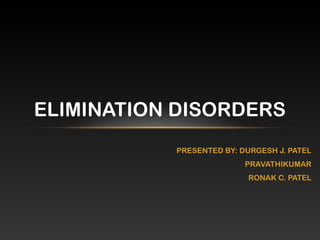
Elimination Disorders: Enuresis and Encopresis
- 1. PRESENTED BY: DURGESH J. PATEL PRAVATHIKUMAR RONAK C. PATEL ELIMINATION DISORDERS
- 2. INTRODUCTION; • The developmental milestones of mastering control over bowel and bladder function are complex processes that occur over a period of months for the typical toddler. • Between 1 and 3 years of age, cortical inhibitory pathways develop allowing the child to have voluntary control over reflexes that control the bladder muscles. • The assessment of fecal soiling includes determining whether the clinical presentation occurs with or without chronic constipation and overflow soiling. • The normal sequence of developing control over bowel and bladder functions is the development of • nocturnal fecal continence, • diurnal fecal continence, • diurnal bladder control, • nocturnal bladder control.
- 3. CONTI… • Toilet training is affected by many factors, such as a • child's intellectual capacity • social maturity, • cultural determinants, • the psychological interactions between child and parents.
- 4. Enuresis And Encopresis Are The Two Elimination Disorders Described In The Text Revision Of The 4th Edition Of Diagnostic And Statistical Manual Of Mental Disorders. • These disorders are considered after age 4 years, for encopresis, and after age 5 years for enuresis, • ENCOPRESIS is defined as a pattern of passing feces in inappropriate places, such as in clothing or other places, at least once per month for 3 consecutive months, whether the passage is involuntary or intentional. • The child with encopresis typically exhibits dysregulated bowel function; • ENURESIS is the repeated voiding of urine into clothes or bed, whether the voiding is involuntary or intentional. The behavior must occur twice weekly for at least 3 months or must cause clinically significant distress or impairment socially or academically.
- 5. ENCOPHORESIS • Epidimiology • decrease drastically with increasing age • 8.1 percent of 3 year olds, • 2.2 percent of 5 year olds, and • 0.75 percent of 10 to 12 year olds. • Males are found to be about six times more likely to have encopresis than females.
- 6. ENCOPHORESIS • Etiology; • Physiological and Psychological factors • Encopresis is considered a nonorganic disorder, a typical child with encopresis may show evidence of • chronic constipation, • leading to infrequent defecation, • withholding of bowel movements, • avoidance of defecation. • Children may avoid the pain of having a bowel movement by holding in the bowel movement, which then leads to impaction and eventual overflow soiling.(75 percent of children). • Some encopretic children have lifelong inefficient and ineffective sphincter control
- 7. • Greater frequency among children with known sexual abuse compared with a normal sample of children. • Associated with measures of maternal hostility, and harsh and punitive parenting. • It is evident that once a given child has developed a pattern of withholding bowel movements with resulting pain with attempts to defecate, a child's fear and resistance to changing the pattern can lead to a power struggle between child and parent over effective toileting behavior.
- 8. PSYCHOGENIC MEGACOLON • A subclinical preexisting anorectal dysfunction exists that contributes to the constipation. • Resulting chronic rectal distention from large, hard fecal masses can cause loss of tone in the rectal wall and desensitization to pressure. • Anecdotal reports indicate that children whose parenting has been harsh and punitive and who have been severely punished for accidents during toilet training are at greater risk of developing encopresis.
- 9. TABLE 47-1 DSM-IV-TR DIAGNOSTIC CRITERIA FOR ENCOPRESIS • Repeated passage of feces into inappropriate places (e.g., clothing or floor) whether involuntary or intentional. • At least one such event a month for at least 3 months. • Chronological age is at least 4 years (or equivalent developmental level). • The behavior is not due exclusively to the direct physiological effects of a substance (e.g., laxatives) or a general medical condition except through a mechanism involving constipation.
- 10. THANK YOU
